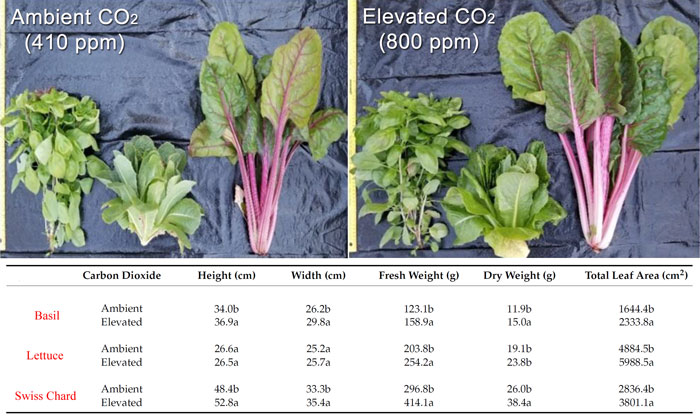| Tweet | Follow @co2science |
Paper Reviewed
Singh, H., Poudel, M.R., Dunn, B.L., Fontanier, C. and Kakani, G. 2020. Effect of greenhouse CO2 supplementation on yield and mineral element concentrations of leafy greens grown using nutrient film technique. Agronomy 10: 323; doi: 10.3390/agronomy10030323.
As the world's population increases, so does its demand for food. Yet, because arable land is decreasing, society must either increase its unit production of food on arable lands or find alternative means to augment its food supply on non-arable lands in order to achieve food security.
One possible method of farming on non-arable lands is to grow plants hydroponically in greenhouses. However, without adequate ventilation in a greenhouse, the CO2 concentration of the air can decline rapidly during the day to values under 200 ppm due to plant photosynthesis, which low CO2 value limits growth. Consequently, growers have long utilized natural gas-burning CO2 generators to keep the CO2 value at or above its concentration in normal air. And that extra CO2 typically leads to greater plant growth and yield, as evidenced in a recent study by Singh et al. (2020).
In performing their work, the five Oklahoma State University researchers grew three leafy greens in a hydroponic setting in a controlled-environment greenhouses at either ambient (~410 ppm) or elevated (~800 ppm) CO2 for 46 days. The leafy greens included basil (Ocimum basilicum, cv Cardinal), lettuce (Lactuca sativa, cv Auvona) and Swiss chard (Beta vulgaris, cv Magenta Sunset). At the end of the experimental period various growth parameters and plant mineral concentrations were measured.
As illustrated in Figure 1, plants grown at higher CO2 were larger and contained greater fresh and dry weight compared to plants grown in ambient CO2 air, with the latter parameter (dry weight) increasing by 26%, 25% and 48% in basil, lettuce and Swiss chard, respectively. Consequently, in light of these observations Singh et al. conclude that "supplemented CO2 has significant potential to increase growth and development of leafy greens grown [hydroponically]," adding "increased growth rate could result in early harvest and more crop cycles each year and thereby help in feeding the increasing world population."
With respect to their findings on plant mineral concentrations, elevated CO2 had no impact on the elemental concentrations of calcium, potassium, sulphur, boron, manganese or zinc in any of the three plant species examined. Nitrogen concentration, however, declined slightly in both the basil and lettuce cultivars in the elevated CO2 treatment, but not in Swiss chard. Phosphorus concentration increased in Swiss chard under elevated CO2, decreased in lettuce and remained unchanged in basil. Both basil and lettuce experienced no change in magnesium concentration at high CO2, whereas the concentration of this mineral declined in Swiss chard. Lastly, iron concentration greatly increased (77%) in basil in the high CO2 treatment and experienced non-significant increases of 26% and 42% in lettuce and Swiss chard, respectively. Consequently, there were relatively minimal impacts of CO2 on the mineral concentrations of the three plants, with the authors concluding elevated CO2 "may have both a positive and negative effect as lower leaf nitrogen concentration might affect available protein, while greater iron concentration in our food ... is a desired quality."

Figure 1. Effect of elevated CO2 on the growth of basil, lettuce and Swiss chard. Means within a given growth parameter of an individual species followed by the same letter are not significantly different at p < 0.05. Adapted from Singh et al. (2020).




